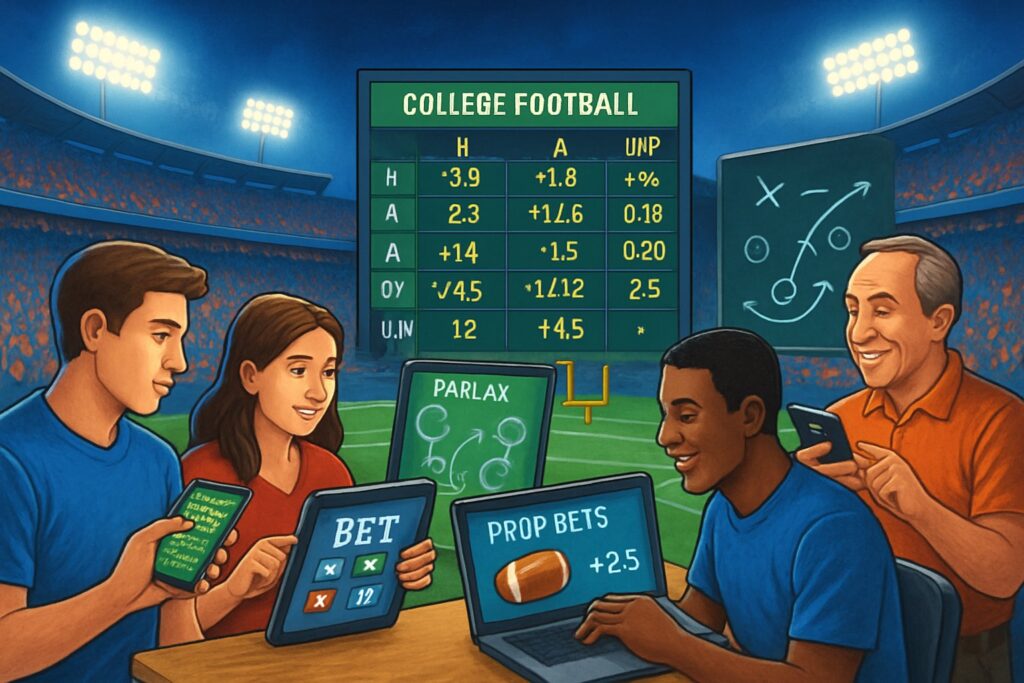by Martin Green
August 9, 2025
Last Updated on August 9, 2025 by Martin Green
College football betting gives you a shot at turning game-day excitement into actual winnings. You make bets by predicting game outcomes through options like point spreads, moneylines, and totals, each with different ways to profit depending on your knowledge and strategy. With so many teams and weekly matchups, there’s a ton of opportunity—sometimes almost too much.

You can keep it straightforward by just picking a winner, or get creative with bets on player stats, combined scores, or multi-leg parlays. Knowing how odds work, what factors move them, and where the value hides is what separates a random guess from a smart wager.
The basics matter: know the rules for each bet, manage your bankroll, and spot when the numbers tilt your way. Once you’ve nailed the fundamentals, you can dig into advanced strategies and find a trustworthy sportsbook to place your bets.

To bet on college football, you need a grip on odds, available wager types, and the NCAA’s unique rules. It’s different from NFL betting, and you also need to know your state’s sports betting laws.
The most common wager types are point spread, moneyline, and over/under totals.
There are also prop bets for player or team stats, and parlays that combine bets for bigger risk and bigger payouts.
Odds show up as positive (+) and negative (-) numbers. A negative means you bet that amount to win $100; a positive shows what you win on a $100 bet.
| Odds Type | Example | Meaning |
|---|---|---|
| -150 | Georgia -150 | Bet $150 to win $100 |
| +130 | Alabama +130 | Bet $100 to win $130 |
Once you can read odds, you can hunt for the best lines across sportsbooks.
NCAA football has way more teams and bigger talent gaps than the NFL, so you’ll see larger point spreads. Spreads of -20 or more pop up all the time against weaker teams.
The season is shorter—most teams play just 12 regular-season games. That means fewer chances to bounce back from a losing streak.
Overtime works differently too. In college, both teams start at the opponent’s 25-yard line until someone leads after a round. This can crank up the score in OT, unlike the NFL’s timed, possession-based format.
And with 50+ games most weeks, you get more betting options, but you’ve also got a lot more research to do. Honestly, it can get overwhelming.
Sports betting laws in the US change depending on the state. Some states allow both online and in-person betting, while others only allow wagers at physical sportsbooks, or ban it altogether.
If your state regulates betting, you’ve got to use a licensed sportsbook. Unregulated sites won’t protect your funds or winnings if something goes sideways.
Some states have extra rules for NCAA betting. For example, a few ban bets on in-state college teams or certain player props.
Always check your state’s gaming commission or regulatory site for up-to-date rules before you bet. That way, you’ll avoid headaches and stay on the right side of the law.

Betting on college football usually means predicting outcomes in a few different ways. You might wager on the margin of victory, pick a straight winner, bet the combined score, or string together multiple picks for bigger risk and reward. Each method has its own odds and rules that shape your payout.
The point spread levels the playing field between the favorite and the underdog. The favorite needs to win by more than the set points to “cover” the spread; the underdog covers if they win outright or lose by fewer points than the spread.
Say Ohio State is -8 against Boston College—they’ve got to win by at least 9 for your bet to cash. If they win by exactly 8, it’s a push and you get your money back.
Most point spreads come with odds like -110, so you’d risk $110 to win $100. Sportsbooks often throw in a half-point (like -7.5) to avoid ties. Betting against the spread means you’re watching the margin, not just who wins.
Moneyline betting is as simple as it gets. Pick the team you think will win, no need to worry about the margin. Favorites show negative odds (like -350), which means you risk more to win less. Underdogs have positive odds (like +350), so you win more if they pull off the upset.
If you bet Ohio State at -350, you’re risking $350 to make $100. But if Boston College is +350 and they win, you pick up $350 on a $100 bet.
Moneylines are great when you’re confident about who wins but don’t want to mess with the spread. Just know that betting favorites pays less, and underdog wins pay more—sometimes a lot more.
Over/under (or total) bets are about the combined final score. The sportsbook sets a number, and you pick if the real total will be over or under that line.
If Ohio State vs. Boston College is set at 55.5, betting the over means you expect 56 or more points total. Betting the under means you want 55 or fewer.
This bet doesn’t care who wins. It’s a favorite when you expect a high- or low-scoring game based on matchups, weather, or playing styles. The half-point keeps things clean—no ties, just wins or losses.
Parlays let you combine two or more bets into one ticket. Every pick—called a “leg”—has to win for the parlay to pay. The odds stack up, so you get bigger risk and a bigger potential reward. You can mix spreads, moneylines, and totals in the same parlay.
For example, you could parlay Ohio State -8, an underdog moneyline, and an over/under pick for a much higher payout than betting them separately.
Teasers are a type of parlay where you shift the spread or total in your favor, usually by 6 or 7 points. That makes it easier to win, but it lowers the payout. Teasers come in handy when spreads are tight and you want a little extra cushion.
Some bets let you focus on individual performances, season-long outcomes, or even live, in-game action instead of just the final score. These options give you more flexibility and let you zero in on specific matchups or moments.
Prop bets in college football cover outcomes not directly tied to the final score. These might be team stats, quarter-by-quarter results, or other game events.
Player props are about individual performances. You could bet on a quarterback’s passing yards, a running back’s rushing touchdowns, or how many field goals a kicker makes.
College rosters can vary a lot in talent, so player props get influenced by matchups, injuries, and even the weather. For example, a strong passing team might struggle in a downpour, which could drag down passing yards.
Common examples:
| Prop Type | Example Bet |
|---|---|
| Team Prop | First team to score 20 points |
| Player Prop | WR to have over 100 receiving yards |
| Game Prop | Will there be a defensive touchdown? |
It’s worth digging into team tendencies, player usage, and opponent strengths before you jump into these bets.
Futures bets let you wager on events that wrap up later in the season.
In college football, popular futures are:
These bets usually have longer odds since there’s more uncertainty. For instance, if you pick the Heisman winner before the season starts and get it right, you could land a hefty payout.
Futures odds shift throughout the season as teams win or lose, players get hurt, and rankings move. Betting early might snag you better odds, but you’re taking on more risk too.
If you track schedules, depth charts, and upcoming matchups, you might spot some value in the futures market.
Live betting, or in-game betting, lets you place wagers after the game kicks off. Odds move in real time based on the score, clock, and team performance.
You could bet on the next team to score, the result of the next drive, or an updated point spread.
Live betting gives you a chance to react to momentum swings. For example, if a starting quarterback goes down mid-game, you can quickly adjust your bet.
But odds can move fast, so you’ll need to make decisions quickly and have a plan before jumping in.
You want a sportsbook that’s licensed, offers fair lines, and pays out reliably. The right site also depends on how many college football options it covers, how easy it is to use, and what kind of promos or bonuses you can snag.
Start by checking licensing and regulation. Pick sportsbooks that run legally in your state or country. That way, your money stays protected and you know the games aren’t rigged.
Look at the college football betting markets each site lists. Some cover every Division I game, while others stick to the big ones. More coverage means more chances to find value, plain and simple.
Test the site’s user interface. You should be able to find lines, place bets, and keep track of your action without a headache. If the site lags or feels clunky, you could miss out on good bets.
Here’s a quick checklist:
| Factor | Why It Matters |
|---|---|
| Licensing | Ensures legal protection |
| Market Coverage | More betting options |
| Site Speed | Faster bet placement |
| Mobile App | Convenient betting anywhere |
You’ll find the same game can have slightly different lines and odds depending on the sportsbook. Even a tiny difference can mess with your long-term profit, believe it or not.
It’s smart to compare point spreads, moneylines, and totals across a few sites. Maybe one book lists a team at -6.5, but another has -7. That half-point? It might decide if you win or just get your bet back.
Some sportsbooks post early lines, and that’s a real edge. If you jump in before odds move on injury news or heavy betting, you can sometimes grab better numbers.
Not every book moves its lines at the same pace. If you keep an eye on line movement, you’ll spot better opportunities by switching sites when it matters.
Most college football betting sites toss out welcome bonuses for new users—stuff like deposit matches, free bets, or risk-free bets. Always check the terms, especially those sneaky wagering requirements.
During the season, you’ll see ongoing promotions like parlay boosts, odds boosts, or even cashback if you lose.
Don’t pick a sportsbook just because the bonus looks huge. Sometimes a smaller, easier-to-clear bonus is worth way more than a massive one with impossible rules.
Keep an eye out for seasonal offers tied to big games like bowl season or the College Football Playoff. These promos can add a little extra juice to your bets.
If you want to make it in college football betting, you need to make decisions based on facts and patterns. You’ll do better if you study team performance, learn how the market moves, and keep your bankroll safe from dumb risks.
Start by looking at recent performance, not just season averages. Teams can turn things around after a quarterback change, or fall apart if they lose key starters.
Check home and away records—some teams just play better at home with the crowd behind them. Weather can mess with teams that rely on the passing game, too.
Take a look at head-to-head results from recent seasons. Sure, past matchups don’t guarantee future results, but you might spot a pattern. Maybe one team always struggles against a certain defense.
Injury reports matter. Even losing one offensive lineman can totally change how a game unfolds.
If you track betting trends, you’ll get a sense of how the market sees a game. Public money usually chases chalk teams – big favorites with big reputations – even when the odds aren’t great.
Look at the handle (total money wagered) versus the number of bets. If just a few bets make up most of the handle, sharp bettors might be dropping big money.
Historical against-the-spread (ATS) records can show you which teams cover the spread and which ones fall short.
Compare opening lines with current odds. If the line moves a lot, something probably happened—an injury, weather, or maybe a respected bettor made a move.
Set a fixed budget for the season and don’t chase losses. Betting more after a loss usually leads to bad decisions.
Stick to a unit system to keep your bet sizes consistent. Maybe 1 unit equals 1% of your bankroll. That way, one bad bet doesn’t wreck your whole season.
Track every bet you make—type (moneyline, spread, total), odds, and result. Over time, you’ll see which strategies actually work for you.
Don’t spread yourself too thin. Betting on too many games just makes it harder to manage your risk and keep track of losses.
Betting odds show you the chance of something happening and tell you how much you’ll win if you’re right. They also bake in the sportsbook’s profit margin, which affects your payout.
Sportsbooks use stats, historical data, and current stuff like injuries or weather to set odds based on how they expect each team to perform.
They adjust odds to balance the money on both sides. That way, they limit their risk and make a profit no matter who wins.
If most people bet on one team, the sportsbook might move the line to get more action on the other side.
You’ll usually see moneyline odds in American, decimal, or fractional formats.
In the U.S., American odds are everywhere.
Point spreads and totals (over/under) usually have odds around -110. That means you risk $110 to win $100. If you get used to the format, you can quickly figure out your risk and reward.
The vigorish or juice is the commission the sportsbook charges. It’s built into the odds so the bookmaker profits over time.
For example, if both sides of a point spread are -110, you bet $110 to win $100. That extra $10? That’s the sportsbook’s cut.
To figure out your payout:
Example: $50 bet at +150 = $50 x 2.50 = $125 total ($75 profit). If you know how juice works, you’ll have an easier time spotting value and avoiding overpriced bets.
If you want to make smart wagers, you need to know how teams match up, how odds get set, and how lines move. You’ll also want to understand different bet types and where to find info you can actually trust.
Look at each team’s recent performance, including wins, losses, and scoring trends.
Check injuries, suspensions, and weather conditions that could affect play.
Also, review head-to-head history and how each team performs at home or away.
The point spread evens the odds between two teams.
A favorite must win by more than the set spread for your bet to win.
An underdog can lose by fewer points than the spread or win outright for your bet to pay.
Research how teams have performed against top-ranked opponents during the season.
Consider how travel, rest days, and neutral-site stadiums might influence play.
Pay attention to coaching strategies and past postseason results.
Use licensed sportsbooks and established sports media outlets.
Look for odds from multiple sources to compare numbers.
Follow analysts who provide data-backed insights rather than only opinions.
Playoff odds can shift based on late-season results and rankings.
Teams with strong playoff chances may rest starters in low-stakes games or play aggressively in must-win situations.
Adjust your bets based on how these motivations might impact performance.
Vegas lines list the point spread, moneyline, and total points for each game.
The spread tells you the expected margin, the moneyline gives you the payout odds, and the total predicts the combined score.
If you look at all three, you can figure out which bet might give you the best value.